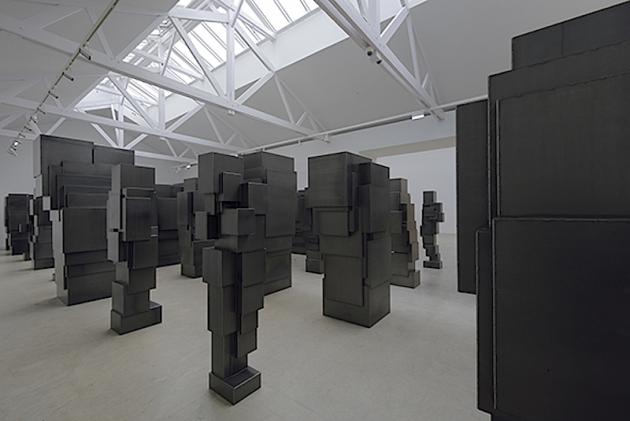Fancy grabbing Eurostar to a major exhibition of sculptures by Antony Gormley? From 1 March the vast halls of Galerie Thaddaeus Ropac in Paris hosts a new show of the Turner Prize winner’s works. The exhibition continues the artist’s investigation of body and space, interrogating the body as place and architecture as the primary conditioner of our experience of space. Antony Gormley fully exploits the scale and volumes of the former foundry sheds that now form the gallery, catalysing our experience of space and time through works that either constitute or are arranged as “fields.” In a recent statement, the artist describes being “increasingly interested in the tropes of framing, containing and constructing being freed from architecture’s shelter function…to make a psychological architecture that allows surface and mass, light and dark, open and closed volumes free play in works that become places for an adventure in real time.”
The first exhibition space is occupied by the work Hole, a four-metre-high model of a house as a body. This work objectifies and internalises the relationship between a perceiving human body and its habitat by mining and perforating the normally closed body-volumes using the languages of cells, corridors, shafts and windows, presenting the subjective body as a mansion of many chambers.
This idea of the transmutation of the anatomical body into interconnected cells is continued in the second gallery space with the installation Expansion Field. The 60 sculptures that constitute this piece are arranged in four rows; a totalised environment constructed in Corten steel sheet from expansions of over 20 fundamental body poses. Each work has been evolved by applying regular increments of expansion to each of the constituent cells of a particular body stack. Together the group of sculptures form a field similar in appearance to the repeated units of a minimalist installation or the rows of megaliths at Carnac.
In the largest and highest space in the exhibition another field is installed. Here, well over life-size cast iron stelae immerse viewers in a forest of totemic presence, in which they are invited to intuit somatic gestalts evoking a variety of emotions, from resistance to delirium.
The final work in the exhibition, Matrix II, is made specifically for the fourth space of the Galerie Thaddaeus Ropac Paris, Pantin. It is virtual architecture, a three-dimensional drawing that identifies 16 room-sized volumes that interconnect around a void space equivalent to two adjacent standing bodies. Using re-enforcing mesh, the skeleton of cast-concrete buildings, Matrix II interrogates the form and structure of the human habitat. This work reveals itself to the gaze of an ambulatory visitor and invites visual penetration, while denying physical access. The challenge of distinguishing foreground, mid-ground and background in the multiple layers of mesh is a vertiginous optical task. As the viewer circulates around the work it creates a disorientating perceptual field in which figure/ground relations become inverted and the accelerating effects of compressed perspective confuses the eye.
The effect of each of these works displayed through the four halls in Pantin is to disorientate the viewers and invite them on a journey of auto-observation. Second Body is a continuation of the artist’s conception of the exhibition as a physical and psychological test site.
A catalogue with texts by the American choreographer William Forsythe, the art historian Guitemie Maldonado and a conversation between Antony Gormley and Hans Ulrich Obrist will be published in spring 2015 to accompany the exhibition.
Antony Gormley was born in London in 1950 and received a degree from Trinity College, Cambridge in Archaeology, Anthropology and History of Art. Upon completing his undergraduate studies, he travelled for three years in India before returning to enroll in London’s Central School of Art, Goldsmiths College, and the Slade School of Art. He was awarded the Turner Prize in 1994, the South Bank Prize in 1999, was made an Officer of the Order of the British Empire (OBE) in 1997 and has been a Royal Academician since 2003. In 2011 he received the Laurence Olivier Award for Outstanding Achievement in Dance in recognition of his set for Sidi Larbi Cherkaoui’s Babel. In 2013 he received the Praemium Imperiale and in 2014 he was made Knight Commander of the Order of the British Empire for Services to the Arts.
Image: Antony Gormley, Expansion Field (installation view), 2015. Courtesy: Galerie Thaddaeus Ropac, Paris/Salzburg. Photo: Charles Duprat.

